Notre Dame doesn’t seem to be a wildly different program since Brian Kelly left for LSU, in some ways you have to squint to see any concrete differences. In some areas that’s a positive sign, in other areas it’s a source of frustration.
On a national level, the 2023 college football season should be the end of an era with the 4-team playoff coming to an end and wider post-season expansion re-framing the sport.
The Irish look like an imperfect football team as the season approaches, however, the arrival of Sam Hartman brings an awful lot of hope to raise the ceiling of a season in a way that didn’t seem possible in recent years. Maybe, just maybe, the stars could align and Notre Dame has what it takes to outscore opponents every week and finally go toe-to-toe offensively with the elite teams in the country.
That’s not to say it’s title or bust for the Irish in 2023 but after this upcoming season you have to wonder what the way forward looks like for the program in a new era.
Lack of Recruiting Momentum
There are plenty of vocal critics of the current recruiting results in South Bend. Even if that’s not the majority opinion of Freeman, it’s clear a big upswing in talent isn’t coming any time soon. Notre Dame is coming off a 2023 cycle that saw the Composite ranking finish 12th nationally, and while the current 2024 class sits at 4th nationally, the momentum is stuck somewhere in neutral.
Notre Dame is in a tough spot. The old adage that play on the field helps the next class sounds great but the Irish need more than that before 2025 cycle. Even if Notre Dame rips it up with Hartman will there be enough time this fall to close out an excellent 2024 class?
For example, during last year’s cycle when November 2022 rolled around 20 out of the 23 commitments were already onboard Notre Dame’s class. Before the season even began, 19 commitments had already given their verbal to the Irish. Gone are the days of using current season momentum to grab top 200 talent in January or February to close out a class.
In general, it’s difficult to envision Notre Dame being great or taking a big step into the next stratosphere in 2024 when they would be breaking in a very inexperienced quarterback (unless they hit the portal jackpot again!) and the longer recruiting stays fine overall the longer odds of the Freeman era being truly different.
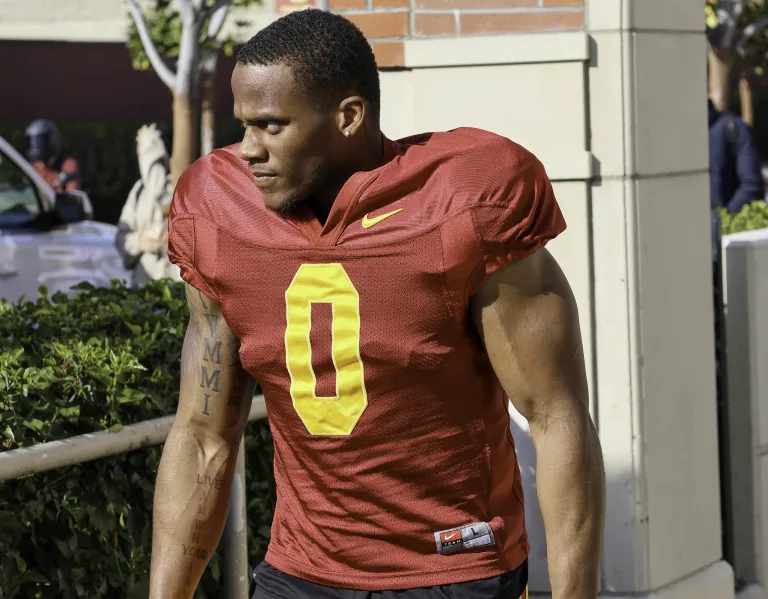
South Carolina running back transfer MarShawn Lloyd had a big spring for USC.
The transfer portal also looms large.
Looking at Notre Dame’s rival in USC makes the discrepancy even worse. To date, the Irish have added 6 transfers (1 who has retired from football) with a pair of 4-star transfers still on the roster. USC has brought in 14 transfers so far, including 9 players who are 4-star transfers per 247. Even if you don’t think momentum is real the truth is USC under Lincoln Riley are trending sharply upward in their talent acquisition while Notre Dame remains closer to its modern recruiting level.
NIL and Redefining the College Experience
At best, Notre Dame doesn’t look or feel comfortable in the NIL era. Going off the statement’s from university leaders there’s definitely a vibe of “We’re not okay with this, can someone in the government please come fix this!?”
However, many of Notre Dame’s actions say that they are not willing to make too much of a fuss or walk away from their historical position (at least in football terms) in order to keep the moral high ground. For now, there’s still a lot of money and cache available from the golden goose.
What is difficult for the Irish is playing the NIL game with one hand tied behind their back. While other schools are discreetly dropping bags to prospective recruits, Notre Dame is promising decent NIL funds once on campus as a student-athlete, with more earning potential for star players. Same as it ever was? Perhaps, although now the transfer portal makes life a little more difficult for Notre Dame.
Amid NCAA president Charlie Baker’s latest visit to Capitol Hill, there is growing movement for federal legislation.
Two bills are in draft form. And a Senate hearing may happen soon. However, some says it’s still a longshot & there’s a deadline in play.https://t.co/Z4ik9gAoIs
— Ross Dellenger (@RossDellenger) May 9, 2023
It also remains unclear what the future of a student-athlete looks like in the modern era. Even if one assumes the NIL waters will recede via market forces (e.g. schools pull back on splashing cash on unproven and fickle recruits in an environment where it’s easier to transfer than ever) or via federal legislation, Notre Dame still has to grapple with many of the same disadvantages in “playing school” that have been present for decades versus situations like Stetson Bennett being in college for 6 years and never graduating from Georgia on his way to back-to-back National Championships.
Conference Realignment & TV Money
Notre Dame has 14 more seasons under the current contract with the ACC and appears to be boxed in as an independent in football making less money than its peers in the Big Ten and SEC. The university is hoping a rumored new $75 million per season deal with NBC will make up a lot of the difference, plus the 12-team playoff expansion provides a cushion, for now, to post-season access.
The new TV contract will likely be celebrated as a major victory for Notre Dame, and perhaps rightly so. Still, you have to wonder with all of the shifting and changes going on what it all means for the future of Fighting Irish football. The Big Ten is adding Notre Dame rival USC (plus UCLA) to its conference for 2024 and NBC will begin broadcasting Big Ten football games–many of them in primetime–starting this fall in 2023. That’s a lot of other college football programs moving on Notre Dame’s corner and potentially weakening the Irish uniqueness in the marketplace.
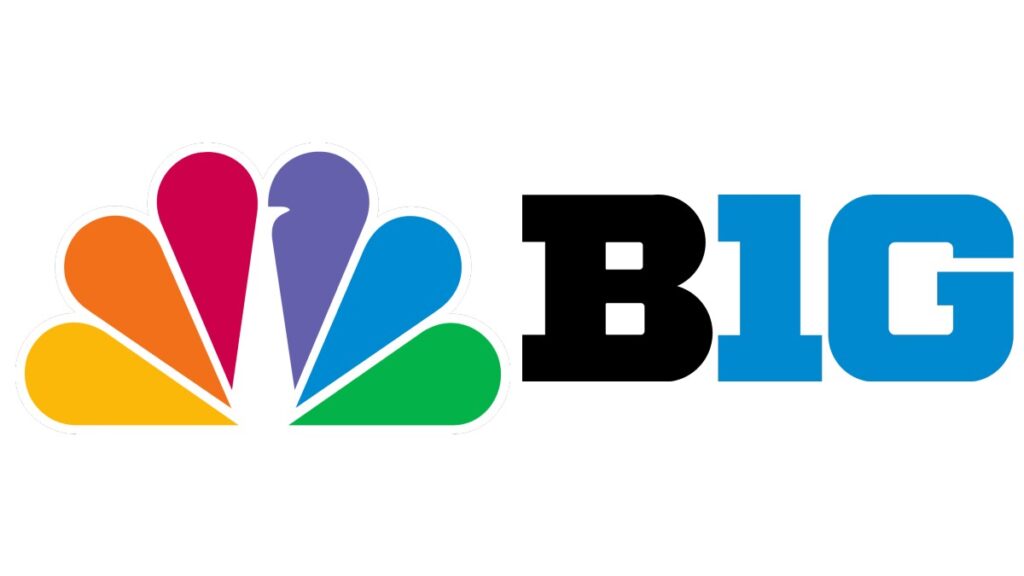
Oh, cool.
It’s been 34 straight seasons since Notre Dame’s last National Championship. That’s nearly as long (36 years) as it took Notre Dame to win its first National Championship after the first season of football at the school. When you look around the landscape, it really seems like Notre Dame needs a thunderbolt of a season in 2023 to keep pace and hopefully break through to another level, particularly in recruiting.
If that doesn’t happen, will the Irish slide even further away from college football’s elite?

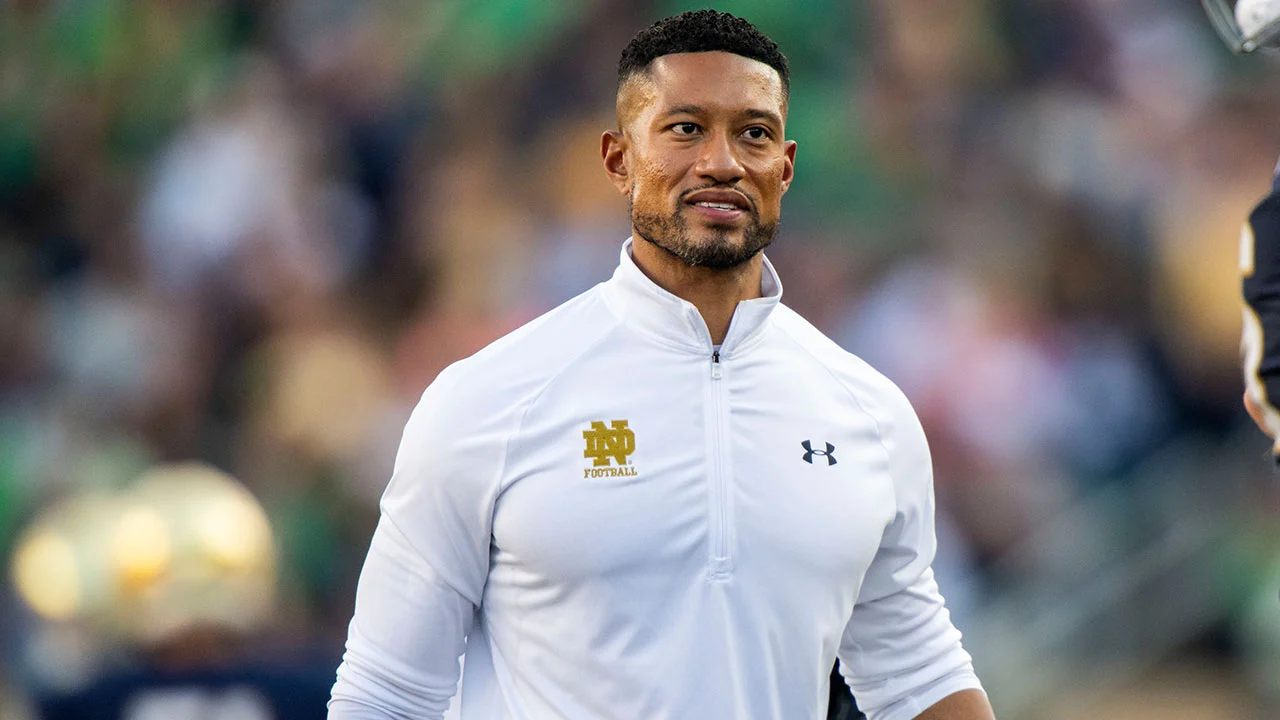
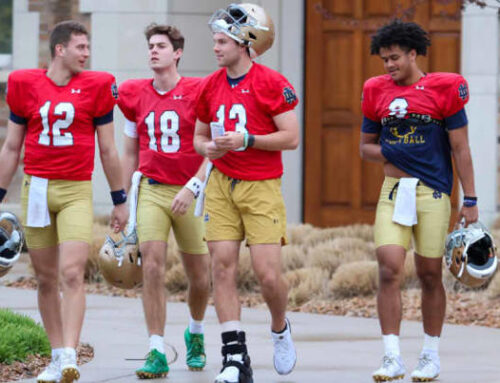
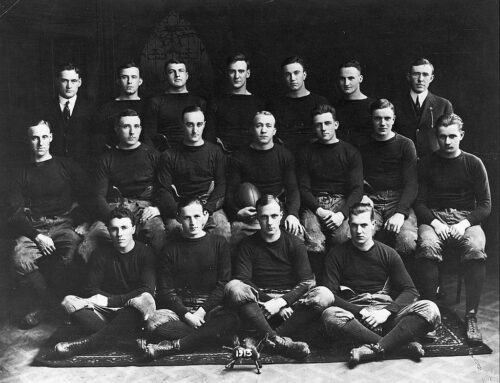

A few quick thoughts…
— I”ll wait in judgement to assess Notre Dame’s relative athletic financial status with the media deal with possible streaming partners and the apparel contract combined with the increase in access to the playoffs
— chasing the leaders in NIL is fruitless and pretty much assures the abandonment of a student-athlete model
— one only needs to look at Texas to see the power involved in that system. The state Board of Regents is made up of alumni of the different state schools. Each has their vested interests. Various UT NIL groups recently combined into one. The head of the Senate subcommittee that could pass legislation on this is Ted Cruz (In link above). Outside of federal legislation, what is the alternative?
— Prime’s Colorado football team composition will have a large contingent of SEC players, a smaller group of ACC players – mostly from Florida State, and a group from Jackson State. What education that ninety percent of the team had – and will have there – is something that excludes them from admission to our school
— Scheduling. With contracts with Stanford and USC expiring and the potential for more games in the playoffs, I’d take a hard look at renewing those, particularly in light of USC’s full-fledged dive into the Transfer Portal. Treat USC as another BiG team with occasional home-and-homes. Games on the West Coast with that exposure can be arranged in other ways. Arguably, those markets may play a part in continuing the status quo.
— Somehow I don’t see ND, alumni and its fans celebrating a conference divisional championship, a second place conference ranking and with a chair on a conference executive committee with the restrictions of a few non-conference games. That membership probably brings with it the NIL race with different state laws governing its public university members.
Mostly agree, except for not playing SC every year. I suspect the B1G is going to pressure SC to either drop us or move us to September, and it’s important that SC tells them to pound sand on that. I think we’re going to need leverage over the B1G in the coming decade.
SC as an institution and a program is gross, but they have been a reliable partner as a football rival and we shouldn’t abandon them.
I would drop Stanford immediately.
That Stanford series…
that’s right
Attempt to kill it only for it to make an improbable comeback in time for Act III?
Not to be too hyperbolic, but it seems like CJ Carr is the most important Notre Dame football recruit since, I dunno, the Rockne era? If he is a top-5 draft pick level good, ND football has a chance to at least tread water and maybe even break into the next tier of the sport. If not, yeah, things could start backsliding pretty easily.
Also this is tangential to something raised above, but the single dumbest thing that touches on the structure of college football and ND was when people tried to argue the 12-team playoff would be affirmatively good for ND. The structure switch disadvantages Notre Dame only more than, oh, every other major program in college football.
I think Swarbrick did what he could for ND with the new CFP structure, but the fact of the matter is for whatever reason people are really hung up on ‘punishing’ ND for not playing a conference championship game. At the very least, he helped devise a format that allows ND to play the G5 rep (or someone worse than the G5 rep) first if they’re in the top 5, followed by the #4 conference champ, so any presumed superteams don’t come up until the semifinals.
But given all the realignment crap swirling, who knows where we’ll even be in 5 years.
Yep, about my take too. A 12-team format that has a ton of at large bids is more advantageous for Notre Dame than many other playoff possibilities that were floated and more conference-centric. It comes with adversity, but as you note, the conferences weren’t going to bend over backwards to give ND all the advantages and none of the disadvantages (i.e. skipping a conference title game) in a new format, which is reasonable enough.
The best would have been the impossible: status quo. But you can’t fight the waves of change, the playoff was always going to expand and always going to make Notre Dame’s path to a championship more difficult. They’re also voluntarily “choosing hard” in that regard by not joining a conference in order to retain independence.
My take on the point of the article is that ND should pursue ways which increase our chances to compete for a NC with opinions on changes that would elevate us into the 1A status that attracts higher ranked recruiting prospects. Should numbers of transfer players be a comparison, Alabama, Georgia, Michigan, Ohio State, etc (the 1As?) use the portal to a limited degree similar to ND. I expect in a year or two, USC will begin decreasing their use of the Portal, too. So, the argument really becomes lowering admission standards for football players and fully committing into the business model where, in cases like Colorado, players commit and transfer in Dec or Jan and transfer to another school in April, possibly without achieving any course credits in pursuit of higher pay. Now that the twelve team playoff will be instituted, do schools shy away from playing national powerhouses rather than increasing their strength of schedule? Should a conference Notre Dame pursue the same strategy?
Ok I guess, but I wouldn’t say admission standards are the key reason why Notre Dame can’t attract talent to compete with 1A tier of schools. It’s the reason ND isn’t active in undergrad transfers, but that is more of a gimmick than a priority. It would be nice to augment things with a high profile guy here or there, but if you want to be 1A, that shouldn’t be the focus.
If ND wants “pursue ways which increase our chances to compete for a NC”, they need more 5-star high school talent. Which probably in the current climates means being more aggressive with upfront NIL to convince those elite players that there’s a reason not to go to a powerhouse school that routinely turns out high draft picks. There’s no reason to go to ND when the path of lesser resistance academically, athletically and financially is in a different direction, thus none of those players ever truly come here.
Yeah I don’t think there are too many 5-star recruits who can’t get through admissions with 900 on their SAT who are dying to go to ND.
ND’s pitch is the degree will set you up for life and we have rich and connected for life. I would think the way to prove it would be to offer *more* upfront NIL money than everyone else, not try your best not to play that game. I agree that is the closest thing to a silver bullet out there, though I’m not sure that alone would get us there. Kind of a necessary-but-maybe-not-sufficient step towards the top tier.
ND is not going to let players in and stay, if they aren’t going to do their work towards a “real” degree. I think they let recruits know this. It’s one reason it’s tougher for them to recruit and a reason it’s harder for them to admit transfers. There are many players out there that would have little chance to succeed at ND. There are more Tee Shepard’s out there than Tony Rice’s.
I think you’re jumbling up a lot of things here. Let’s try to organize a bit.
1. Primarily, ND needs to recruit better talent out of high school. This is where most of our talent comes from and will come from in the future. It was the main reason (perhaps the only reason) for hiring Freeman. However, NIL seems to be a problem here. We can get commitments from 5-stars but cannot hold them. I suspect there is some uneasiness about the quality of our coaching staff too, but I think the main issue is NIL, not admissions.
2. ND can use the transfer portal to supplement positions of need with older and graduate players, like Hartman. ND seems to have no interest in going the transfer heavy route a la SC or Colorado, so those aren’t useful comparisons. FWIW, I don’t think we should go that route either.
3. The remaining stuff about scheduling and the playoffs and conferences is ancillary. ND has shown zero ability to win major postseason games in the past 30 years. We are simply not a real factor in the national title race and recruits’ perception of us is not going to change until that changes.
I’ll try to clear up the confusion, while acknowledging two of your contributions (2&3) address current policies, which I support and would not change despite whether it eliminates a pool of possible recruits. We may not attract the Dante Moores and move on to the Kenny Mincheys.
— if we miss on a Manning, Keeley, Bowen, Graham or Rushing, that’s arguable whether NIL policy changes would correct those misses
— while a traditionalist in policies and direction, i am not one so much to not consider. a review the USC rivalry. perhaps an occasional home-and-home series
— it does take both sides, also, and USC may do the same. Perhaps they don’t want that tough a non-conference schedule like many other BIGs
— future policies IMO is not to chase NIL increases and admit en masse while highlighting the education that ND provides and maintaining admission standards should clear up any comparison to Colorados
— player decisions are often made after those first two years. Could we keep a Diggs from returning closer to home or promises to be the featured back in transfer siren songs?
— I too expect ND to continue to accept selected grad transfers or those who wish to commit to pursuing a quality education.
All of that may highlight some of our views contrary to the article’s shade on the future direction of Irish football policies.
The defense recruiting seems really odd so far. It was precisely what Freeman excelled at in his first 2 years at ND but now it’s filled with a bunch of lower-rated recruits. Either there’s something wrong (and Golden is a big part of that) or they’ll look like geniuses if they got a lot of great recruits early if these prospects shoot up the rankings in the next 9 months. Obviously it’s more likely somewhere in between but either way it’s not great.
The back 7 recruiting IMO is satisfactory. The concern is with the defensive line.
With that said for all positions, they need to going forward land some top 150 guys on defense as opposed to 3 star projects.
I’d counter that by saying the back 7 is what scares me a little. The CB recruits are high 3*/low 4*, and we’re trusting Mickens has a “type”. LB has been great in recent years but suddenly this year they are taking flyers on a bunch of 3*s. S recruiting is somewhat scary lately – the current starters seem adequate, but recruiting results has not been good.
At least with DL, they are still in on Rushing, Scot, Umeh, Lightfoot, Thomas, and Williams.
Gray and even Bell are higher than what you said for CB. Add in Morrison and CB isn’t a worry in the near future, gotta have more perspective than just the 2024 class.
LB was awesome last year and though down this year, if there’s any position they can go and turn back on quickly next cycle for defense it’s going to be Freeman and linebackers. I’ve got less than no concern for the future there.
DL they’re “in” on those type of guys, but rarely ever get them, and at best will probably get one on that list, but more likely zero. That’s a real issue for recruiting, probably the biggest one right now is that ND can’t attract surefire and ready made DL, they have to develop and hope to get enough hits along the way.
You’re right about Gray/Bell/Morrison. I was mainly commenting on this year’s class, as overall it seems to be noticeably lower overall at a lot of defensive positions.
And I agree about not always landing those stud DL recruits — my hope is that by being in on that many, that they’ll land a couple of them
Ah, gotcha. I actually do buy that Hobbs could be very under-rated but we’ll see. Overall given the track record of recent success at CB, I’m not worked up about a somewhat down cycle.
I guess those are the ebbs and flows, kinda like LB this year as well. If you get 2-3 top-150 LBs each and every year, do you run the risk that more will leave when they don’t play?
Makes some sense to have some peaks and valleys to maybe get kids in ’24 who need development time while D. Bowen and Ausberry are playing in a few years, and not bound to get frustrated and leave.
I hope you’re right on DL, but I would say that is the biggest weakness is trying to get top-30, 50 or 100 players with that body type into Notre Dame. You almost rarely see that happen in recent years.
I saw it pointed out on an ISD article (something we are probably all aware of) a lot of this staff is from the Cincinnati team that beat ND and made it to the playoffs and had a number of draft picks. The problem with that is that recognizing a low 4 star or high 3 star that can be a highly productive in a couple of years is good, but we need quality depth, not developmental depth, we need the high 4 stars and a few 5 stars to compete and win in the playoffs. Cincinnati didn’t fare any better against Alabama than Notre Dame did, and arguably Alabama had an off year when they met Cincy in the playoffs. The two deep at every position needs to be 1A and 1B, and if one of them gets hurt, then the 2 comes in, and that 2 is going to be 1A or 1B next year when 1A gets taken in the 1st three rounds of the draft.
I love an underdog story as much as the next person, but for ND, those underdogs have to be the two and three star walk-ons that make it into the two deep, we can’t be giving them scholarships hoping they develop as projected.
Admittedly looking at the draft the last two years, Kelly seems to have left the cupboard fairly empty, and maybe Freeman is just trying to get it restocked with basic staples. Hopefully 2018 through 2020 isn’t the best ND can do going forward.
DL should really be a (the?) major focus of our Transfer targets. As you’ve said, ND has had to have guys grow and develop into stars there; but lots of teams need that development from those guys. So often, players there need to add so much strength (and just mass in general) when they get to college; very few linemen (D and O) are stars in year 1 or 2 in college. Letting other schools grow and develop those guys, and then poaching them late, is a strategy that COULD work well. (Of course if you whiff on those transfer for a year or two, you’re in big trouble)
Grad transfers or transfers? Because I don’t think they’ll be too many options for transfers at DL.
Yeah, I agree. The DL that develop well are going to the NFL not the grad trasnfer portal.
That said, there’s a kid from JMU who was first-team All-Sun Belt last year and is in the portal. Not exactly the second coming of Isiah Foskey, but probably could help for depth at the least. I think that’s about the best of the bunch, other than that Utah State kid ND was interested a bit in over the winter, I think he’s still out there too.
I think most DL transfers are G5 trying to prove themselves at a P5 school and increase their potential to be drafted.
That would make sense. I’m probably a little gunshy on the Cain Madden hype for just how well that will work out for the big team to take on that type of talent 🙂
OTOH: it seems to me that d-line (and this is just a perception; I could be wrong) is the position with one of the highest hit rates in terms of 5-stars generally being very good.
Bodie Kahoun commits to ND.
I am very optimistic about 2023.
After that, I guess it depends on what your longer-term expectations are. I don’t think winning a national championship is realistic for ND in the current model, and it will be even less realistic in the 12-team playoff model, particularly when you combine that with a virtually unrestricted free agent market that ND seems to be somewhat ambivalent about participating in.
My goals for the next 7-10 years of the program would be:
-Stay solidly, unquestionably, in the 1B tier of college football, even at the expense of moving up to 1A. I think our current level of recruiting and transfers can accomplish this and I think Freeman has the right overall strategy here. Mostly we just need to avoid coaching hires that are (A) stupidly risky or (B) too insular.
-Figure out an exit from the ACC before it hits major crisis mode. Reminder to Jack that they aren’t our “partners” or “peers” and will not do us any favors on the way out. They are southern basketball schools. Relatedly….
-Start seeing if there are schools interested in competitive, high-level college football that is not fully professionalized and/or dominated by the deep south. The answer to this may be a collection of what are currently B1G and PAC 12 teams.
If your last paragraph means NIL instead of pay to play, in a system with real policing, I’m all for that. There have to be quite a few schools interested in that. The way things are currently, is a mess.
Pretty much that, yeah.
I hate even the inference of manifesting these words into reality, but I think it’s inevitable ND ends up in the B1G at some point, whatever mutant form that takes. I guess once that happens I’ll have to make myself feel better with the fact that whatever the B1G with 18+ teams in it would look like, it won’t remotely be conference membership in the way we used to know it.
Exactly. I’m thinking of it more as “joining college football” than “joining the B1G.”
The good news is we have some time here — let’s see how SC and UCLA are treated and who else is added. A 20+ team league that goes from coast to coast, and isn’t for the exclusive benefit of Michigan and Ohio State, wouldn’t be a bad destination for us.
E — you seem to be more plugged into what’s going on than a lot of us. Are the recruiting issues really as simple as NIL? Is it the straw to break the camel’s back? Seems like ND has been dealing with academic restrictions, cold climate, and the fact that a religious school is not for everyone. And now, adding NIL on top of that is just becoming too much to overcome? And then, to top it off, ND cannot replenish or fill gaps as easily though the portal.
I think it’s a matter of perspective, especially when initial expectations wre that Freeman would be like the ND version Kirby Smart and turn recruiting instantly into top-3 or 5 powerhouse like flicking on a light-switch. Hasn’t happened and won’t happen for all the various reasons.
But I don’t think there’s such a reason for a pessimistic outlook, or that there hasn’t been progress just because there hasn’t been as much progress as hoped. As I wrote in the comment section of the Urlacher commit, ND has two top-50 locked down for 2024 and decent enough chances with at least two more (Lambert, Scott, maybe even Rushing?). Any further conversions make it a very, very strong class.
Just maybe not as much improvement as it was hoped that Freeman could muster. And now the outside factors (NIL, portal, playoff expansion) are all swirling to conspire to make winning that much tougher, when it’s already been tough.
Or Eric just had a really bad case of the Sunday Scaries yesterday.
I think it’s a combo of many things with recruiting. About a week ago when I started this article I just had this thought that 2023 could be really fun but we are currently RKG-ing quite a bit in recruiting. Then it got existential.
This is the problem that is hurting ND recruiting and I think we’re seeing a change from Freeman and team this cycle because of it. He’s still upgrading the talent and I think the focus is to go and load up and get as many 4 stars/top 300 players as possible. I think you’ll see a bump in some of these guys who are 3* now. It’s the same old thing that everyone has said and continues to say, until ND really decides they want to actually win again then this is who they are.
I think how E phrases it above is spot on and the problem with ND leadership. They are just whining and asking for someone else to come in and change instead of leading the change. Instead of coming up with something new and exciting that would drive forward player equity and be a trailblazer for true student athletes, they just want to pound their foot and say, “Mom/Dad, Billy took the ball and is changing the rules, please someone come and change it back.”
The hardest part for me is I really want Freeman to succeed. First black head coach in the NCAA to win a National Championship, while graduating 95% of the team, and pushing player equity forward is what it should be about. But unfortunately I don’t think it’s going to happen again at ND.